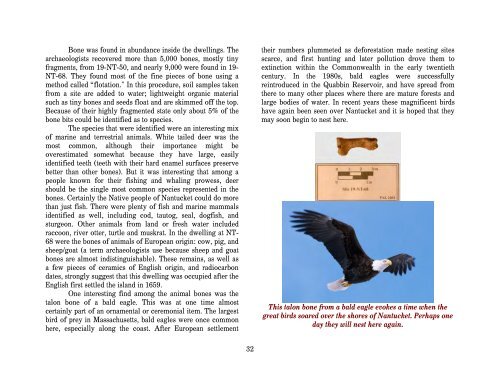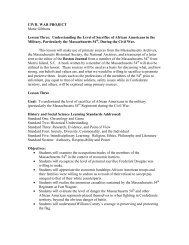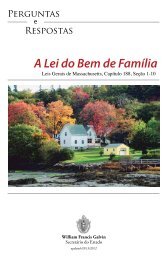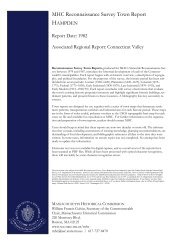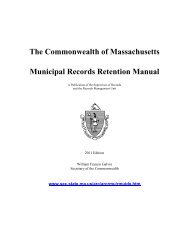Roads, Rails, and Trails - Secretary of the Commonwealth
Roads, Rails, and Trails - Secretary of the Commonwealth
Roads, Rails, and Trails - Secretary of the Commonwealth
Create successful ePaper yourself
Turn your PDF publications into a flip-book with our unique Google optimized e-Paper software.
Bone was found in abundance inside <strong>the</strong> dwellings. The<br />
archaeologists recovered more than 5,000 bones, mostly tiny<br />
fragments, from 19-NT-50, <strong>and</strong> nearly 9,000 were found in 19-<br />
NT-68. They found most <strong>of</strong> <strong>the</strong> fine pieces <strong>of</strong> bone using a<br />
method called “flotation." In this procedure, soil samples taken<br />
from a site are added to water; lightweight organic material<br />
such as tiny bones <strong>and</strong> seeds float <strong>and</strong> are skimmed <strong>of</strong>f <strong>the</strong> top.<br />
Because <strong>of</strong> <strong>the</strong>ir highly fragmented state only about 5% <strong>of</strong> <strong>the</strong><br />
bone bits could be identified as to species.<br />
The species that were identified were an interesting mix<br />
<strong>of</strong> marine <strong>and</strong> terrestrial animals. White tailed deer was <strong>the</strong><br />
most common, although <strong>the</strong>ir importance might be<br />
overestimated somewhat because <strong>the</strong>y have large, easily<br />
identified teeth (teeth with <strong>the</strong>ir hard enamel surfaces preserve<br />
better than o<strong>the</strong>r bones). But it was interesting that among a<br />
people known for <strong>the</strong>ir fishing <strong>and</strong> whaling prowess, deer<br />
should be <strong>the</strong> single most common species represented in <strong>the</strong><br />
bones. Certainly <strong>the</strong> Native people <strong>of</strong> Nantucket could do more<br />
than just fish. There were plenty <strong>of</strong> fish <strong>and</strong> marine mammals<br />
identified as well, including cod, tautog, seal, dogfish, <strong>and</strong><br />
sturgeon. O<strong>the</strong>r animals from l<strong>and</strong> or fresh water included<br />
raccoon, river otter, turtle <strong>and</strong> muskrat. In <strong>the</strong> dwelling at NT-<br />
68 were <strong>the</strong> bones <strong>of</strong> animals <strong>of</strong> European origin: cow, pig, <strong>and</strong><br />
sheep/goat (a term archaeologists use because sheep <strong>and</strong> goat<br />
bones are almost indistinguishable). These remains, as well as<br />
a few pieces <strong>of</strong> ceramics <strong>of</strong> English origin, <strong>and</strong> radiocarbon<br />
dates, strongly suggest that this dwelling was occupied after <strong>the</strong><br />
English first settled <strong>the</strong> isl<strong>and</strong> in 1659.<br />
One interesting find among <strong>the</strong> animal bones was <strong>the</strong><br />
talon bone <strong>of</strong> a bald eagle. This was at one time almost<br />
certainly part <strong>of</strong> an ornamental or ceremonial item. The largest<br />
bird <strong>of</strong> prey in Massachusetts, bald eagles were once common<br />
here, especially along <strong>the</strong> coast. After European settlement<br />
32<br />
<strong>the</strong>ir numbers plummeted as deforestation made nesting sites<br />
scarce, <strong>and</strong> first hunting <strong>and</strong> later pollution drove <strong>the</strong>m to<br />
extinction within <strong>the</strong> <strong>Commonwealth</strong> in <strong>the</strong> early twentieth<br />
century. In <strong>the</strong> 1980s, bald eagles were successfully<br />
reintroduced in <strong>the</strong> Quabbin Reservoir, <strong>and</strong> have spread from<br />
<strong>the</strong>re to many o<strong>the</strong>r places where <strong>the</strong>re are mature forests <strong>and</strong><br />
large bodies <strong>of</strong> water. In recent years <strong>the</strong>se magnificent birds<br />
have again been seen over Nantucket <strong>and</strong> it is hoped that <strong>the</strong>y<br />
may soon begin to nest here.<br />
This talon bone from a bald eagle evokes a time when <strong>the</strong><br />
great birds soared over <strong>the</strong> shores <strong>of</strong> Nantucket. Perhaps one<br />
day <strong>the</strong>y will nest here again.


